Data organization on QNAP NAS
QNAP NAS presents its storage space to end users as shared folders, providing an easy way to keep files in a remote location and access them over the network. However, such a container is just one of multiple layers that comprise the architecture of this device. The actual data is typically distributed between multiple drives, that are themselves arranged into a single system. Special structures can also be used by QNAP to achieve data integrity, increased flexibility and accelerated speed. Read on to find out more about the underlying principles of data organization on QNAP NAS, comprehension of which is important if you want to configure the storage or recover folders and files lost from it.
RAID configurations of QNAP NAS
As a rule, the drives contained in the QNAP NAS box are joined together to form a RAID group. Unlike Synology or Drobo, QNAP doesn’t have its proprietary RAID technology. However, most of the units support traditional software-driven RAID. The set of available RAID types may differ depending on the model. The possible options are as follows:
Single-drive configurations do not offer any performance gains or tolerance against physical failures. They are used seldom, mainly in entry-level NAS boxes for non-critical data or in combination with a solid backup plan.
RAID 0 merges the space of two or more drives using the striping technique. It doesn’t provide any failure protection as well, yet, enables higher read/write speeds without any loss in capacity.
RAID 1 clones the same data onto two separate drives. If either of them fails, it is still possible to obtain the copy from the other drive in the set. Such a scheme offers a high level of protection, yet, is not very efficient in terms of capacity, as the half of it cannot be used.
RAID 5 distributes the data in stripes together with parity blocks across three or more drives. In case one of them breaks down, the data it holds can be restored with the help of parity. This level allows achieving an optimal balance between fault tolerance, performance and capacity, considering that parity consumes storage space equal to one member drive.
RAID 6 stripes the data and dual parity across four or more drives. Thus, even when two drives fail concurrently, it is still possible to recover the configuration using the remaining ones. This RAID type offers a very high level of data protection and fast performance, however, the capacity equivalent to two drives renders inaccessible.
JBOD can be created on two or more drives. The data is written to the first drive until it gets full. After that, writing proceeds to the next drive in the sequence. Such a setup is generally not recommended due to the lack of fault tolerance or performance gains. The only benefit it has is the possibility to use the entire capacity of the array.
RAID 10 requires any even number of drives, starting from 4. A copy of data is stored on each pair of drives that are striped together, like in RAID 0. The array can be restored as long as at least one drive in the pair remains operable. Such a layout accelerates performance and ensures solid data protection, yet, only 50% of its capacity is usable.
RAID 50 is created from 6 or more drives. Each three drives are combined into a RAID 5 set and the data is striped like in RAID 0. The information can be retrieved as long as at least two drives in each RAID 5 configuration are functioning. This scheme offers better data integrity and performance than RAID 5, whereas up to 30% of capacity is wasted, which is less when compared to RAID 10.
RAID 60 is very similar to RAID 50, but requires at least 8 drives and assembles each group of four into RAID 6. Such a configuration ensures even better reliability, being able to withstand the failure of up to two drives in each RAID 6 set. However, the use of disk space is less efficient, given that up to 50% of the capacity can be lost.
RAID-TP is a triple-parity array available only for QNAP appliances running ZFS-based QuTS hero. Such a configuration provides enhanced redundancy, enough to protect the storage against three simultaneous drive failures.
RAID-TM is a triple-mirror setup that can be applied only on ZFS-based QNAP NAS as well. In such an array, three drives duplicate each other, which leaves even more possibilities to restore the data. The downside is, obviously, that just one-third of its total capacity remains accessible.
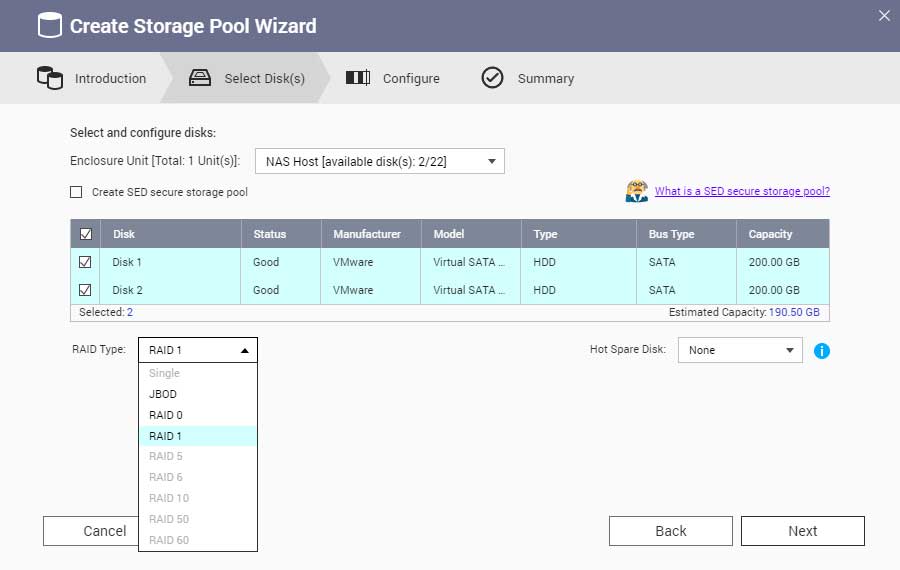
Pic. 1. RAID configurations on QNAP NAS.
Logical volumes on QNAP NAS
Logical volumes on QNAP NAS can be created directly on a single drive/RAID group or with the help of Linux LVM. In the first scenario, a static volume with a fixed size allocates the available storage capacity right away, just like a conventional partition. In the second scenario, a storage pool acts as an additional layer of abstraction between the physical storage and volumes on top of it. Such a pool aggregates the capacity of all selected drives or RAID groups and provides the ability to set up flexible volumes within it. Flexible volumes can be resized and support various advanced features, like snapshots or Qtier.
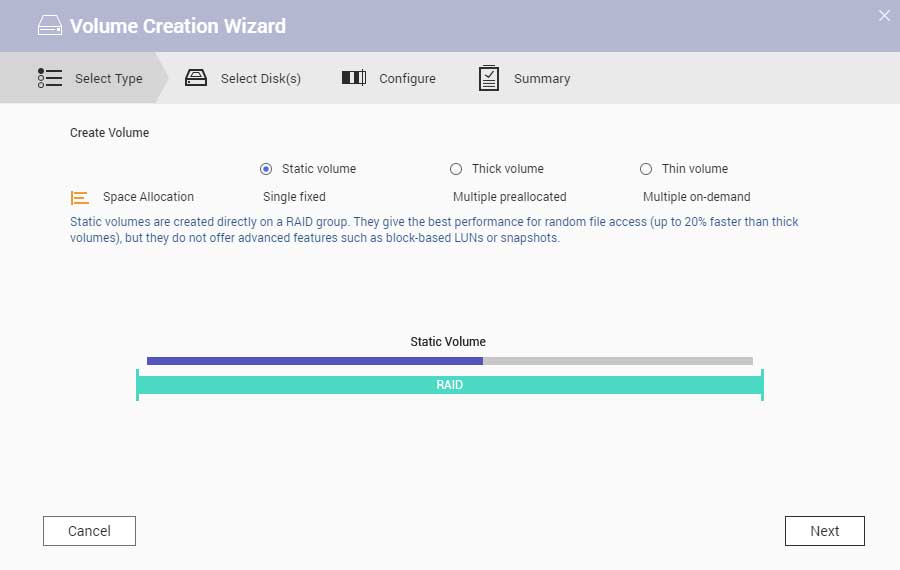
Pic. 2. Static volume on QNAP NAS.
There are two different types of flexible volumes. A thick volume is the default choice for devices that support storage pools. The size of the volume is defined by the user upon creation, and the equal amount of space is immediately reserved in the storage pool. This portion of space will always be at its disposal, even when the rest of the pool is used up by other volumes.
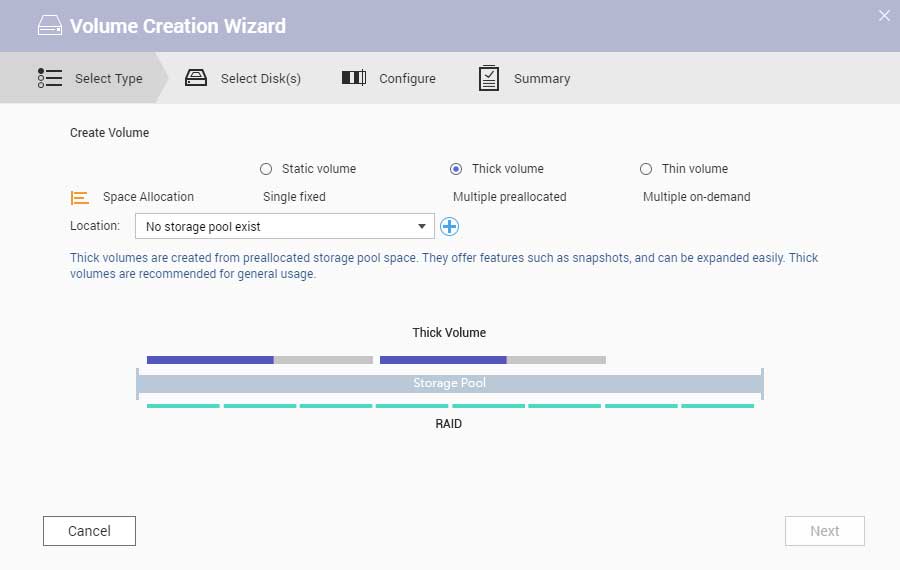
Pic. 3. Thick volume on QNAP NAS.
A thin volume doesn’t reserve any space in advance, only as actual data is written to it. The available capacity of the pool is shared by all thin volumes using the thin provisioning mechanism of LVM. When the data gets deleted, the released space is returned to the pool and can be utilized by other volumes as required.
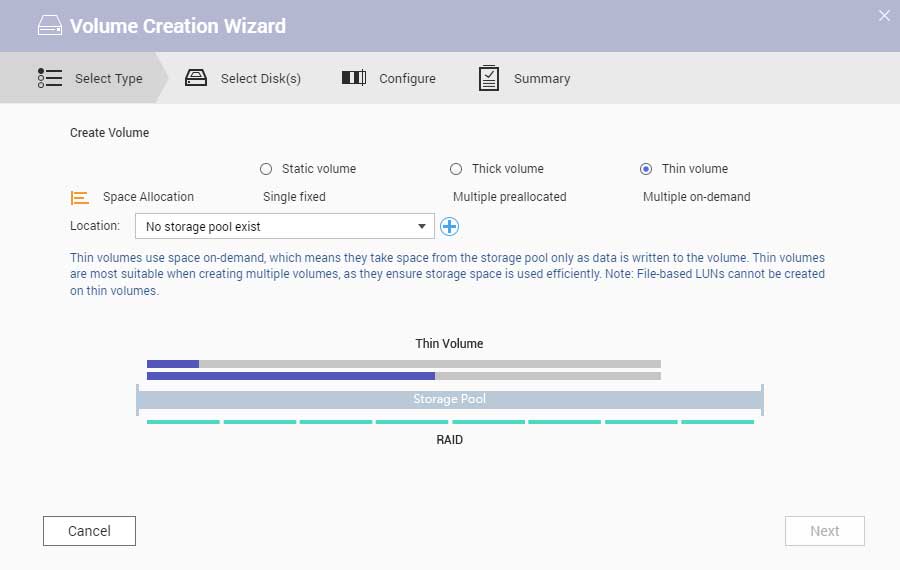
Pic. 4. Thin volume on QNAP NAS.
Any logical volume can contain multiple shared folders that are used to place files. The NAS itself also creates a few service folders for its own needs. Though not visible via the network, they exist within the volume and occupy a certain amount of storage space.
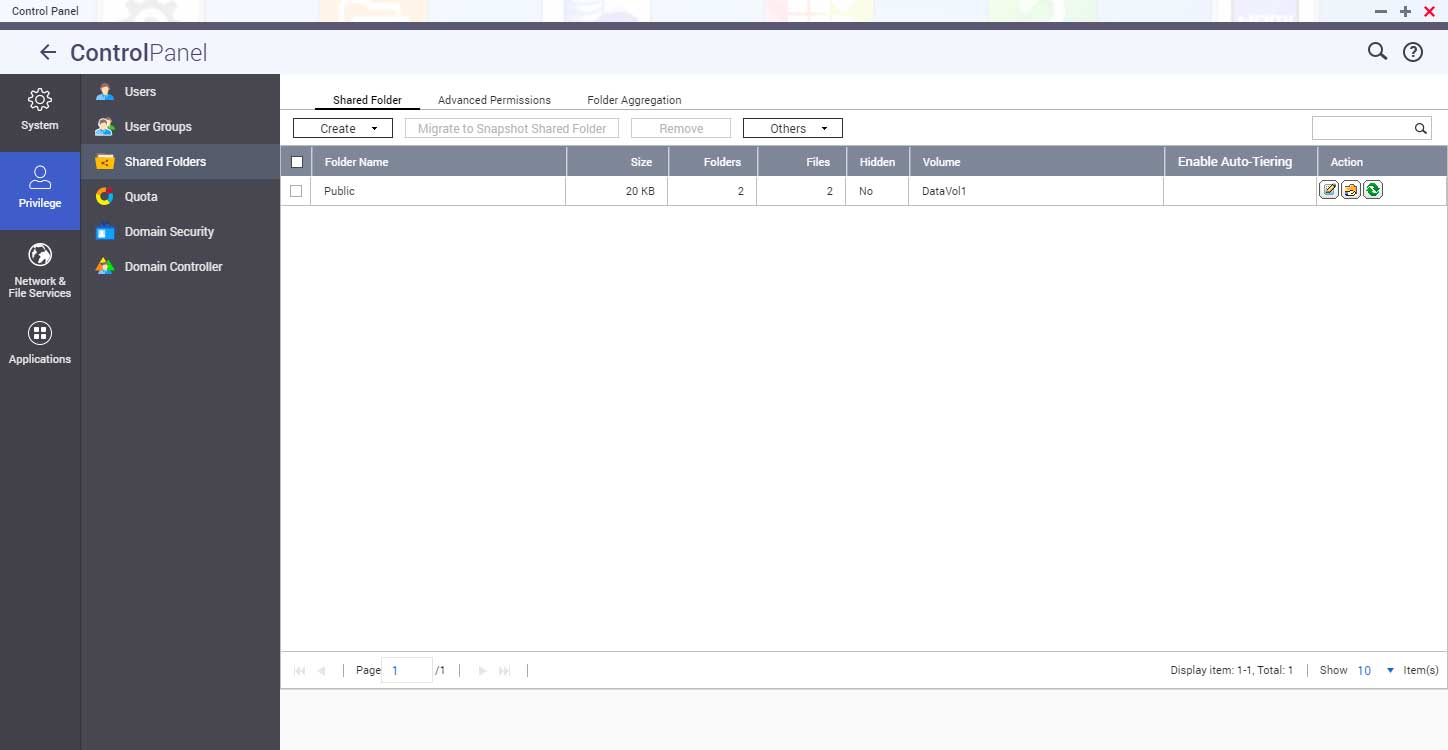
Pic. 5. Shared folder on QNAP NAS.
Additional storage technologies implemented on QNAP
Certain QNAP models allow their volumes to take additional advantage of the flash memory. A special SSD cache can be set up on any solid-stated drive mounted in the box and used as a temporary read and/or write buffer to bring accelerated performance to the selected volume. The caching feature can be configured as LRU, and then the least-used items are removed from the cache when it is full, or as FIFO, and then the oldest items are eliminated.
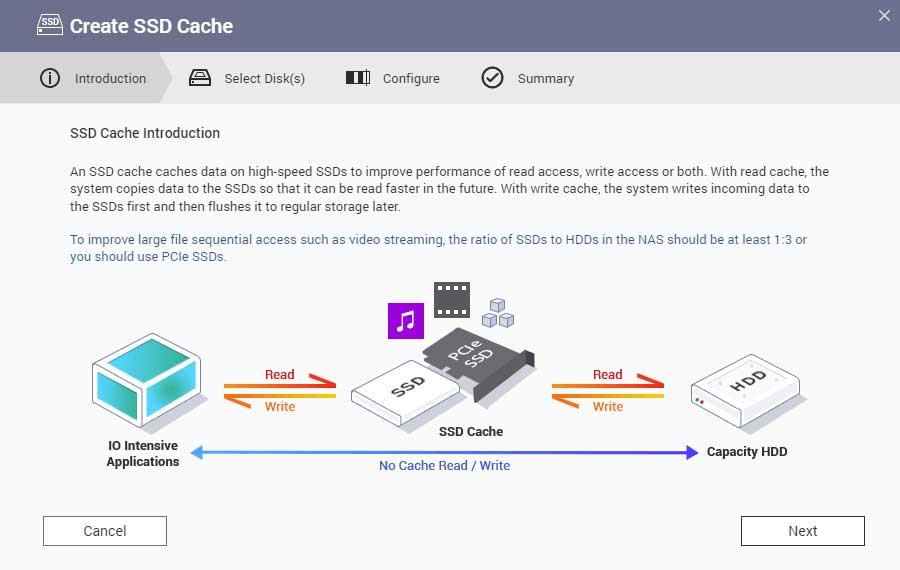
Pic. 6. SSD cache on QNAP NAS.
Some models running QTS also support the Qtier technology that transfers the data automatically between faster SSDs and slower mechanical drives in the storage pool based on the access frequency. Relocation is performed with the help of the thin provisioning functionality.
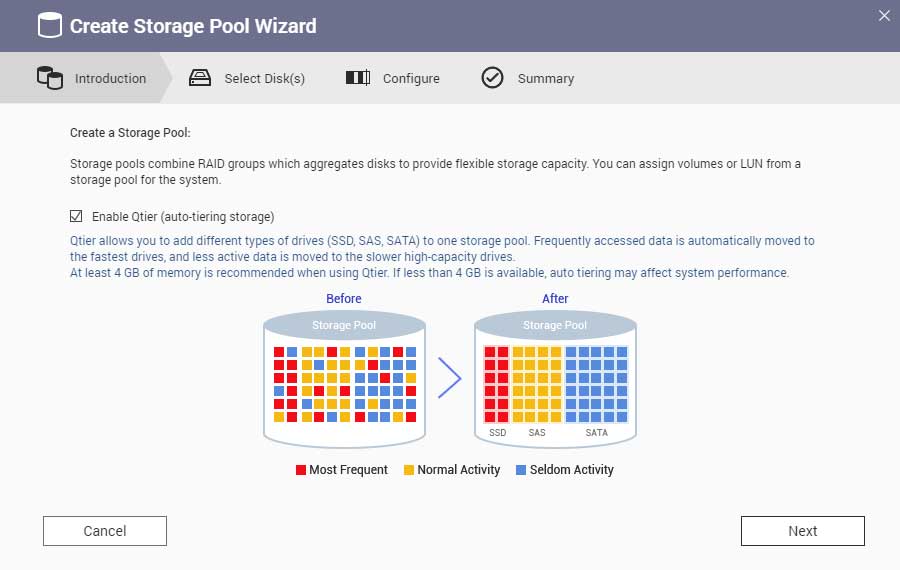
Pic. 7. Qtier on QNAP NAS.
Volumes on most QNAP models can be encrypted with the help of the 256-bit AES algorithm. The technology is based on the Linux LUKS standard. However, QNAP employs its proprietary techniques to transform the decryption password specified by the user and decipher the volume. In addition, an encryption key based on this password can be generated and exported manually when encryption is set up or later on. This key is stored as a 256-byte-file in the *.key format that can be uploaded as an alternative method of storage decryption. Some appliances also offer folder-based encryption implemented via eCryptFS.
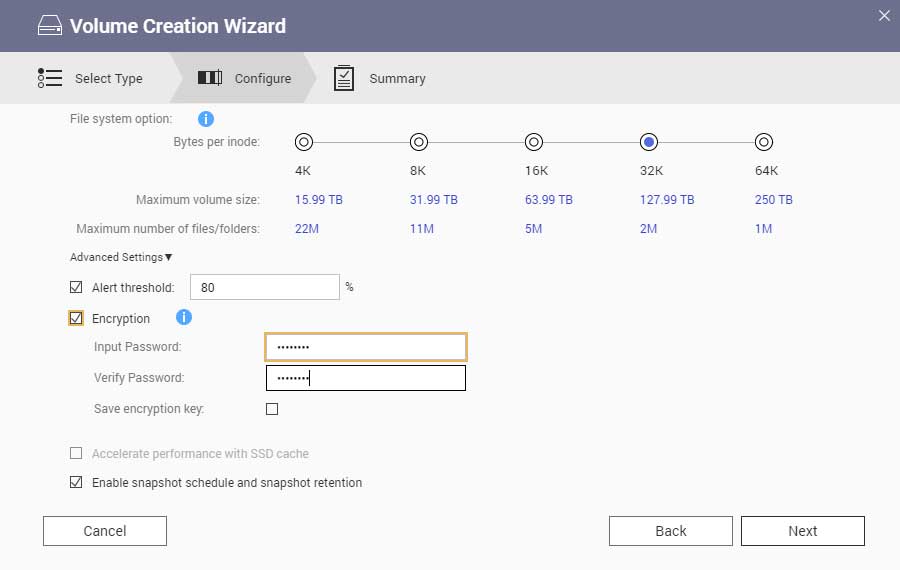
Pic. 8. Volume encryption on QNAP NAS.
There are also QNAP models that support self-encrypting drives (SED). In this case, encryption is performed on the hardware level: the data gets encrypted automatically as it is written to the drive. The data encryption key (DEK) is stored on the drive and is used by its built-in controller to cipher and decipher the data. DEK itself can also be encrypted with the help of an authentication encryption key (AEK) defined by the user. A valid authentication key must be provided to read the DEK and thus unlock the drive. QNAP allows using such drives individually, and also makes it possible to create a fully encrypted storage pool on their basis.
Please refer to the respective article for further information on general peculiarities of QNAP NAS units, issues that commonly lead to their data loss and the process of data recovery.
Last update: September 28, 2022
